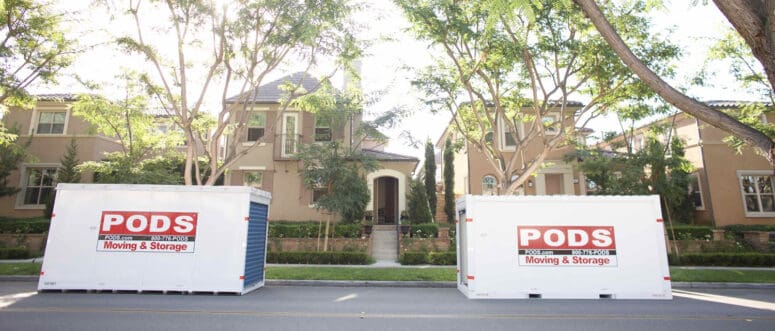Moving, Contained: Pros and Cons for Every Portable Moving Containers Option
- Published on
- 9 min read
-
 Eric Bates Contributing AuthorClose
Eric Bates Contributing AuthorClose Eric Bates Contributing Author
Eric Bates Contributing AuthorEric Bates is an editor and writer with more than a decade of experience covering culture and lifestyles. He lives in Los Angeles.
Few chores are as unpleasant as moving. Anyone who has ever undertaken a major move, whether local or long-distance, has reached the point of near breakdown while frantically scrambling to find the box in which the movers placed some important item or hitting the limits of their spatial reasoning in trying to get a couch up the stairs.
Thankfully, there are more options than there used to be. Over the past two decades, the moving game has been changed by the emergence of moving containers: portable containers that get dropped off at your house, to be filled, then picked up and delivered to a storage center or your new home. It is a kind of consumer extension of the logic of containerization that remade commercial freight shipping — and with it, the entire global economy.
Here we’ll explore all the pros and cons of moving containers and undertake detailed comparisons between all the major products on offer. Whether your priority is savings, convenience, or security, you’ll learn which portable moving container is the best fit for your needs.

Why use moving containers?
While containers might not be right for every moving situation, they have been the perfect solution for many customers.
North Carolina-based real estate agent Sandra Savage, of Realty World Carolina Properties, enthuses: “Think freedom along with convenience. Utilizing a container system of moving allows you to save money by packing up some of your items on your own. Can you move everything with a container? Maybe not, but I think of them as a favorite tool in your moving toolbox.”
Jordan Bennett, an agent with Keller Williams in Mission Viejo, California, likewise endorses containers from a customer perspective. “The cool thing is that, versus packing your entire house over a weekend, you have some flexibility. The container was in our driveway, and we gradually put things in at our own pace.”
Bennett emphasizes that the benefits are even more significant on the other side of the move. If you’re using a moving truck, you need to unload it right away in order to return the vehicle on time, executing two large undertakings in a single day. containers, on the other hand, function as “a floating storage unit…it’s a lot more flexible, and you save money on not having to do that double-move situation.”
When not to use portable moving containers
For other agents, however, the advent of containers has been a mixed blessing. Beth Pretty, a Keller Williams agent in Chesterfield County, Virginia, notes that “the most economical way to use them is to leave them in your driveway, but unfortunately, that looks horrible in listing photos. So I now really discourage my clients from going that route.”
As Bennett suggests, however, in most situations, the seller could take advantage of containers in the window after closing a sale — during the escrow period, for example. But he concurs: “I would never encourage someone to have one of those out front during selling.”
How do moving containers work?
In outline, the processes for receiving, packing, and using the containers is the same for all the companies surveyed here. The container is delivered to your driveway or parking space, then left for either a set period of time or indefinitely, charged at a monthly rate. Once you’ve loaded it up, nearly all of these companies offer three options (any exceptions are noted below).
- They’ll pick up the container and transport it to your new home.
- They’ll pick up the container and move it to a remote storage facility.
- The container will stay on your property as an at-home storage unit (for a monthly fee).

Which container company do I choose?
A number of companies offer moving container options, from the pioneer PODS (Portable On-Demand Storage) to familiar moving giants like U-Haul to upstart competitors such as SMARTBOX.
While there are broad similarities between the services these companies provide, the small differences can be a big deal depending on your situation.
PODS
The daddy of them all, the PODS brand was founded in 1998 and pioneered not only the concept of shipping container-like units for home moving and storage, but also the hydraulic lift delivery system that brings them to and from the customer’s doorsteps.
The units are made of weatherproofed plywood, supported by steel frames. A clear roof lets in daylight. The doors roll up, rather than swing, creating extra room within the container and allowing for a tighter fit in the driveway or on the street. Ground-level access obviates any need for a ramp. Each container also features built-in tie-down rings, allowing you to easily secure your heaviest items.
The basic costs include 30 days of free storage, leaving you plenty of time to pack up your belongings.
Pros
Flexibility and wide geographic availability are the primary factors that set PODS apart from their imitators.
PODS are available for moving and storage in 44 U.S. states, as well as parts of Canada, the UK, and Australia.
While many competitors offer only a single container size, PODS has three. Their 7-foot container is comparable to a 10’ rental truck or a 5’x10’ storage unit, designed for smaller moves, like studio apartments or college dorms. Their largest container, a 16-footer, should hold the objects from a space of 1,200 square feet or smaller. The 12-foot container is right for everything in between, though it is only available for storage and local moves.
If you’d rather skip the DIY route, the company has a large network of packing and loading assistance providers to which they can refer you.
There are also military discounts: 10% off whether you’re on active duty, retired, or a veteran.
Cons
It is difficult to generalize too much about container prices, since the costs vary significantly depending on the details of your move, but by most accounts, PODS is rarely the cheapest option.
That problem is exacerbated by the fact that PODS doesn’t offer quotes as seamlessly as some competitors, requiring a phone call to finalize any offer.
Additionally, the company’s prominence and name recognition means that the competition for available units is often stiffer than elsewhere. If you plan to rely on PODS for your move, you should make sure to book as far in advance as possible.
U-Box
U-Box is the portable storage and shipping container offered by moving industry giant U-Haul. These wood boxes feature a barn-style door, which requires more clearance space than the PODS product, but it will not jam, and the company claims it is more difficult to break into.
They come in only one size, with a little over 250 cubic feet of space, holding up to 2,000 pounds. Order as many containers as you think you’ll need, and you can return any extras free of charge.
Pros
Because they’re offered by U-Haul, U-Boxes are available throughout the country. It’s the only one of these products you can be certain to find in your local area.
Pricing is also a little more straightforward. For storage, the units cost $50 to $60 per month. To move a single unit, the average costs are $1,000 locally and $2,000 internationally. You can reserve your containers online, without making an additional phone call.
The U-Box service is also highly reliable, offering a guaranteed delivery date. Should the company somehow miss that date, they pay customers $50 for each day that passes between the deadline and arrival.
Furthermore, U-Haul offers a wider range of insurance options than competitors, allowing customers to purchase greater peace of mind in an arrangement that suits their particular situation.
All U-Box bookings include free storage pads.
Cons
Even though U-Box makes it easy to book multiple units with little risk of overpaying, the single-sized containers come with serious limitations. Some larger items, like beds and sofas, simply may not fit in the unit or can only be included through extreme inefficiency.
The containers’ wooden construction may also be seen as a downside to many, offering less protection against break-ins and accidental damage than those with steel siding or frames.
U-Haul also requires you to purchase your own lock to secure the unit — a small, but no less frustrating, hidden cost.

SMARTBOX
A smaller upstart, SMARTBOX offers a product that is similar in outline to U-Box. The company’s storage and moving containers are made of wood (which is covered in a waterproof canvas material to prevent leaks) and come in one size, with interior space of about 230 cubic feet and a weight limit of 3,000 pounds. The box should be able to accommodate a single room worth of belongings. The company can deliver up to eight boxes in one trip.
Pros
SMARTBOX is a great option for those working on a tight budget. The company’s prices generally average lower than competitors — but even more, it offers a price-match guarantee if you’re able to locate a better offer.
The company’s ability to deliver so many containers at once also exerts a downward influence on costs, relieving customers from paying for multiple trips.
Cons
The chief downside to SMARTBOX is the company’s relatively small footprint. As of January 2020, it only has locations in 23 US states and territories, ruling the option out for those who live elsewhere.
As with U-Box, the wooden container may also be less desirable in certain circumstances.
1-800-PACK-RAT
1-800-PACK-RAT’s units are made with corrugated, weatherproof steel, and come in three sizes. These generally match the capacity of the different units offered by PODs, but their smallest size, 8 feet, offers a little more room than PODs’ 7-footer. Like U-Box, they are fitted with barn-style doors.
Pros
For those using the pods for storage rather than a move, the company’s facilities outpace most of the competition, offering 24-hour surveillance and climate control.
Its all-metal containers offer security and peace of mind.
The company has brick-and-mortar locations in more than 30 states, and the capacity to serve customers in 97% of the country, regardless of the proximity of a physical outlet.
Additionally, the company strives for transparency. All price quotes are binding, and $10,000 in liability insurance is built into the cost of all long-distance moves.
1-800-Pack-Rat also provides a wide variety of special discounts — and, like SMARTBOX, it matches competitors’ prices.
Cons
While 1-800-PACK-RAT covers a wide swath of the US, it is still considerably less accessible than either PODs or U-Box.
The company also makes it more difficult to understand its prices or secure a binding quote than some other competitors, requiring a phone call to finalize the deal.

ReloCube
The ReloCube is a product from U-Pack. They come in one size, with just over 300 cubic feet of interior space and 2,500 pound maximum weight. It is comparable to the seven-foot-sized PODS container, with a slightly smaller length.
Though U-Pack makes it very easy for customers to get an accurate price quote for their own situation, it is difficult to generalize about the costs entailed because they vary significantly based on location, size, distance, availability, and time of year.
Pros
One factor that distinguishes the ReloCube from most of its competitors is that the pricing does not include 30 days of free storage. Instead, U-Pack charges per business day. This brings down the costs and offers a major advantage for those who are planning to execute their moves as quickly as possible, especially if you are planning to pack and move over the course of a weekend.
This pricing structure also allows for its own kind of flexibility. Unlike every other competitor, you will not pay a deposit for the ReloCube, but rather pay upon pick-up. This also serves to free up some cash on-hand during the relocation period.
The size and shape of the ReloCube also sets it apart from the other container companies. It has been designed to fit within a single parking space, making it ideal for customers in locations with higher population density, where space comes at a premium.
Widely available, ReloCubes can be used in all 50 US States, as well as Puerto Rico, and parts of Canada.
A final favorable distinction is that U-Pack offers final quotes online, whereas those working with other companies will have to make a phone call.
Cons
The biggest downside to U-Pack’s ReloCube is that they are not available for local moves: just long-distance and state-to-state moves or storage.
The additional charge for 30-day storage that gives ReloCube an advantage for some reasons will be a disadvantage to those who’d like to move at a more leisurely pace.
Another consideration is that, based on a handful of sample estimates, U-Pack’s moving trailer services run cheaper than the ReloCube, meaning that it’s probably not the best choice for any movers seeking out containers on the basis of savings.
Also worth noting is that ReloCubes, like U-Boxes, do not come equipped with locks, requiring customers to purchase their own.
Go Mini’s
Go Mini’s is much less widely available than most of the other options addressed here. But under the right circumstances, it offers a few options that might make it the best fit. The units come in three sizes: 12, 16, and 20 feet. A handful of franchises offer an additional 8-unit container — all of them with a slightly larger cubic footage than the comparable PODS models.
Pros
There are two primary ways in which Go Mini’s distinguishes itself. Firstly, the company offers the largest available sized container: a 20-footer that can hold around 5 to 6 rooms’ worth of belongings.
Second, Go Mini’s patented design goes further than many other options to protect your belongings. The units are made with steel frames and steel siding that is coated with a paint that prevents sweating. Pressure treated floors offer additional moisture resistance, as does venting and eight inches of ground clearance. Where most of the other companies offer either swing doors or locking roll-up — each of which have their pluses and minuses — the Go Mini’s collection includes units with each, allowing customers to tailor the choice to the job.
Cons
Consisting of individual franchises, Go Mini’s containers can only be used for local moves in areas that happen to be served by a franchisee. This will rule the company out for many movers. Furthermore, the franchise model means that prices and service quality vary greatly from location to location.
The company’s smaller size also means fewer available units, making competition fierce in busy moving months, especially late summer.
More minor quibbles include the fact that sales tax isn’t figured into quotes, leaving the total charge a bit mysterious. Additionally, Go Mini’s does not directly offer insurance, leaving the customer to locate a third-party carrier if they want to protect their most valuable items.
Zippy Shell
When Zippy Shell was founded in 2007, it was Australia’s first portable storage unit and moving company. It arrived in the US in 2010 and now has franchises in 28 states, servicing both local and long-distance moves.
Zippy Shell’s containers differ from the classic container model. Coming in 10- and 15-foot sizes, the units are delivered in a wheeled trailer — the Zippy Shell itself — that fits the dimensions of two urban parking spaces. Instead of being loaded and unloaded via hydraulic lift, the Zippy Shell simply hitches to a truck. The container is then removed for easy loading.
In contrast to the rest of the competition, the company also offers full-service moves, if you’d like to combine the convenience of the portable storage container with the ease of movers. For those more budget conscious, or who would simply prefer to load their items themselves, there is also a self-loading option.
Costs include a free month of storage.
Pros
Zippy Shell’s unique delivery system and sizing makes it ideal for denser areas, as well as apartment building parking lots.
By offering a full-service option, the company provides a kind of flexibility not available elsewhere.
Zippy Shell containers have a much higher maximum weight limit than any of the other companies surveyed here, able to carry up to 10,000 pounds, making it the best fit for those with a particularly heavy load.
Cons
As with many of the smaller companies here, Zippy Shell is available in fewer places than giants like PODS and U-Haul.
The company’s website is much sparser and more difficult to navigate than other competitors’ sites, making it more difficult to get a full picture of how it will fit your particular needs.
As with Go Mini’s, the options vary across the company’s franchises — even the scope of what is covered by the delivery fee changes from location to location.
Finally, unlike all the other options here, Zippy Shell does not offer a home storage option. While storage is available at the company’s remote units, they will leave the containers with you for a maximum of three days.

Happy moving!
Whether using moving containers or a different moving method is the best fit for your move will depend on your budget and the specifics of your trip and your belongings. But this handy guide should make it easy to hash out which company is the best for your circumstances should you decide to go the portable container route. Don’t forget to consult with your agent to make sure you’re on the same page about logistics!
Header Image Source (re-sized): (HireAHelper/ Flickr/Creative Commons Legal Code)
All product names, logos, and brands are property of their respective owners. All company, product and service names used in this website are for identification purposes only. Use of these names, logos, and brands does not imply endorsement or any affiliation with HomeLight.
